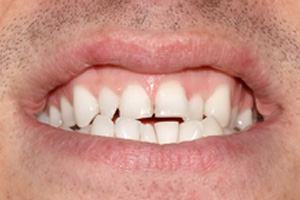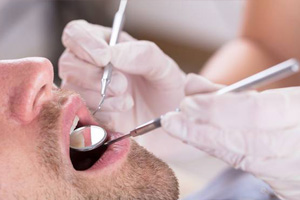Crown Lengthening in Worcester

Take a look at your smile in a mirror. Most people have just a little if any gum tissue showing when they smile. However, if you see too much gum, then this can detract from the appearance of your smile. This is called excessive gingival display, or more commonly a gummy smile. Fortunately, your periodontist in Worcester offers treatment to gently remove excess gum tissue that exposes more tooth structure. This creates a more balanced smile.
How Does a Gummy Smile Happen?
 Having too much gum tissue showing when you smile is usually the result of three main factors. First, your upper teeth may not have come in normally. If this happens, then these teeth may be partially hidden behind excessive gum tissue. Consequently, they will appear to look too short.
Having too much gum tissue showing when you smile is usually the result of three main factors. First, your upper teeth may not have come in normally. If this happens, then these teeth may be partially hidden behind excessive gum tissue. Consequently, they will appear to look too short.
Another reason can be hyperactivity of the muscles that control the movement of your upper lip. In this case, your lip may rise too high when you smile, thereby showing too much gum tissue.
Last, the growth and development of your upper jawbone can cause a gummy smile. If the bone protrudes underneath your gums, you may end up with teeth that look stubby or short.
What Constitutes a Balanced Smile?

To determine the proper balance of your smile, the periodontist looks at the smile line. This line constitutes the portion of teeth that show when you smile. Ideally, a smile line should reveal only a little bit of gum tissue if any at all. Gum tissue that is visible when you smile should run evenly along your teeth and be in harmony with your upper lip.
Your smile line is also influenced by:
- The shape and size of your lips
- The muscles in your face
- Size and shape of your teeth
- Gum tissue
How Does Crown Lengthening Treat a Gummy Smile?
If you think you have a gummy smile, then schedule a consultation with the periodontist in Worcester. He will examine your teeth, gum tissue, mouth and lips. Digital X-rays will be needed to see the bone structure underneath your gums. With all of this information, we will be able to determine the extent of your excessive gingival display and recommend treatment.
In many cases, crown lengthening can solve the problem of a gummy smile. Crown lengthening is a surgical procedure to remove excess gum tissue and reveal more of your natural tooth structure. Crown lengthening can be performed on one or several teeth in order to create a more even gum line and more natural looking smile.
This procedure can be performed for cosmetic purposes or to prepare the site for a dental crown restoration.
Crown Lengthening FAQs

If you’re unhappy with the appearance of your smile due to an excessive amount of gum tissue, it may be worth considering a crown lengthening treatment. Step one is to visit our office for a consultation. Not only will our team be able to confirm whether you’re a viable candidate for crown lengthening, but we can also answer any questions you might have about the process. Check the FAQs below to find the answers to some of the most common crown lengthening questions.
Does Crown Lengthening Hurt?
Before we begin your crown lengthening treatment, we will administer a local anesthetic to help prevent you from experiencing discomfort. Sedation can potentially be used as well, particularly if you’re nervous about your upcoming procedure.
In the days following crown lengthening, your mouth may be somewhat sore. Taking ibuprofen (or another type of pain reliever) may help. Be sure to only eat soft foods for a while. You should also avoid chewing with the area where the procedure was performed. The discomfort should start to subside on its own after a few days. Many patients feel normal again within a week’s time.
What Can You Expect Before a Crown Lengthening Procedure?
When determining whether crown lengthening is right for you, we will first need to take a look at your medical history. In some cases, you may be a viable candidate, but you might need to stop taking certain medications before the treatment, such as those that thin the blood.
Sometimes crown lengthening is done to make room for a dental crown. In order to protect the tooth in question, a temporary crown might be attached. This also has the benefit of showing us just how much soft tissue will need to be removed for the actual crown.
What is Recovery Like After Crown Lengthening?
Typically, you will need to spend at least one day resting; that means no vigorous exercise of any kind. Be sure to follow any dietary instructions that our team gives you. Avoid eating anything particularly hot, sticky, hard, brittle, or acidic while your mouth is still healing.
You should periodically hold a cold compress over the site where crown lengthening was performed; this will help keep swelling down. It’s not a good idea to use a cold compress for too long, so make sure to only apply it for 15-minute intervals.
When Can You Brush After Crown Lengthening?
Immediately after the crown lengthening procedure, you won’t be able to brush the teeth in the area that was treated. That said, you should be able to brush the rest of your smile like normal after the first 24 hours. Make sure that your toothbrush has soft bristles, and be gentle during your oral hygiene routine.
To help keep your smile as clean as possible, it’s recommended that you rinse with mouthwash or salt water multiple times a day.

